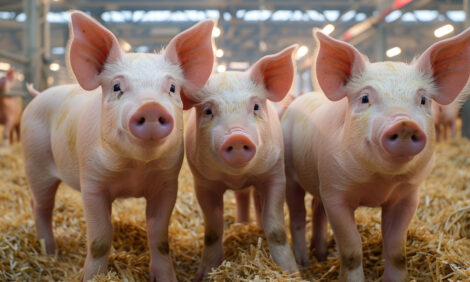



European Pig Statistics and Production Forecasts - April 2003
By Claude Vidal, Francis Weiler and Robert Poschacher, Eurostat - This article combines two reports from Eurostat. The first looks at pig numbers in the European Union and the second reviews estimated pig production to the second quarter of 2003 and concludes with a survey on pig populations in April, May and June 2002.
| European Pig Statistics |
The European Union produces one in five of the world's pigs. This production comes from a substantial and highly concentrated pig population estimated at 123 million animals in 2000.
Nine regions, covering 10 % of the Utilised Agricultural Area (UAA), account for half
the total number and over 50% of Europe's pigs are produced by holdings with over 1,000 pigs.
The potential impact of the pig population on the environment is therefore significant, although various agricultural practices are being introduced to help reduce pollution
from this sector.
One in five of the world's pigs comes from the European Union.
The production of pigmeat in the EU was estimated at 17.6 million carcass
equivalent tonnes in 2000, which is about one-fifth of world production.
This
production increased by 11 % between 1995 and 1999 despite the outbreak
of swine fever in 1996-97. Following a situation of overproduction which led to
a drop in prices in 1998 and 1999, production was down slightly in 2000, thus
marking the end of a production cycle.
In Germany, production remained
stagnant until 1997, returning in 1998 to its 1991 level of 3.8 million tonnes
per annum (Figure 1).
Spain saw a substantial increase in production
throughout this period (+55 %); in 2000, it produced close to 3 million tonnes,
making it the EU's second-largest producer.
In Denmark (+28 %), where
pigmeat accounted for 79 % of the country's meat production in 2000, and in
France (+21 %), production has also increased although it is tending now to
level off.
In the Netherlands, leaving aside the swine fever outbreak of 1997,
the dip in production in recent years can be attributed to the political decision
to reduce the pig population.

To continue reading this PDF report and and view all the tables Click Here
| EU Production Forecasts for Second Quarter 2003 |
According to the market forecasts by the Member States and Eurostat, pig production in the European Union (EU-15) in 2002 was 0.5% up on 2001.
Up to the first half of 2003 production is forecast to decrease by 0.2% compared with 2002. The survey on pig populations in April, May and June show a decline of 0.8% in 2002 compared with the previous year. The total pig population in the EU is therefore 120.2 million.
Downward trend in pig populations in the EU
Surveys on pig populations in the EU Member States in April/May-
June 2002 show a slight decline in relation to 2001 (-0.8%).
This figure
of 120.2 million, which corresponds to approximately 13% of the world
pig population, is still relatively high.
The largest decreases were
recorded in the Netherlands and the United Kingdom, while in Spain
the total pig population rose by 4.6%.
A slight downward trend in pig production
Figure 1 shows trends in gross indigenous production (GIP) on the pig
market from the first quarter of 1999 to the second quarter of 2003.
There is a slight downward trend in pig production, although it remains
at a relatively high level. Pigmeat production always tends to be
highest in the last quarter of the year.
GIP in the individual Member
States (see table) shows that pig production is on the decline
particularly in Luxembourg, the Netherlands and the United Kingdom.
The five biggest producers of pigmeat in EU-15 are Denmark,
Germany, Spain, France and the Netherlands, which together account
for more than 73% of total EU output.

To view the full PDF report and tables Click Here
Source: Eurostat - Statistics in focus AGRICULTURE AND FISHERIES THEME 5. - January 2003
© European Communities, 2003








